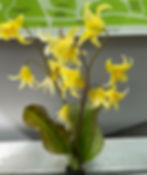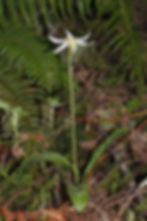Learn to Love ... Native Spring Ephemerals
- lesannsa
- Mar 5, 2023
- 8 min read
Updated: Jul 8
What exactly is an 'ephemeral' plant? An ephemeral plant is one that has a very brief life cycle. They are transitory plants. In BC, many of our native woodland wildflowers are spring ephemerals - for example, trilliums, Fawn lilies, Bleeding hearts, and Shooting stars.
In spring, before the trees leaf out, sunlight penetrates the woodland, warming the forest floor, and triggering the emergence of these plants. They burst out of the leaf litter, grow rapidly, flower early, quickly produce seed, and then fade away. The plants do not die... but rather lie dormant underground during the hot days of summer, waiting for the return of cool and moist growing conditions.

Photo: A colony of trilliums. In the background, blue woodland anemones. Taken at VanDusen Botanical Garden, Vancouver BC. April 2022.
A colony of native wildflowers in bloom is a magical sight. You will appreciate these plants even more, if you know a little bit about their life cycle. Let's take Western trillium (Trillium ovatum) for example. Trilliums are part of the lily family. In BC, the Western trillium can be found in coniferous and mixed deciduous-coniferous forests. They have one of the earliest, and largest, flowers in our forests. A common name is "wake-robin", for they appear when the robins "wake-up".
Trilliums are "Ant Plants". They need ants to spread their seeds. Other "Ant Plants" include Fawn lilies, Bleeding hearts, Inside-out flower, and Wild ginger. Up to one third of our spring blooming woodland plants rely on ants to disperse their seeds. The dispersal of fruits and seed by ants is called myrmecochory: ancient greek 'myrmeks' (ant) and 'khoreia' (circular dance). Each trillium, produces only one seed capsule with a small number of seeds inside. The seeds themselves have a "tasty snack" attached to the outside of the seed. This appendage is called an eliaosome. It is filled with proteins and lipids that attract ants. The ants collect these rich snacks, drag them away from the flower, and back into their underground nests. Here they feed on the eliaosome and discard the seed. The seed is now in a protected environment, waiting to germinate. And wait it does....

Photo: An ant, eliaosome in it's jaws, carrying a seed. (Image credit: Mike Dunn)
Trillium seeds may take up to two years to germinate. After the seedling germinates it stays in the cotyledon stage, underground, for one whole summer. Over the next few summers, the young plant grows slowly ... pushing out one leaf, then two leaves and finally, (after three or four years), three leaves.

Photo: Trillium ovatum flower. 'Trillium' means "in threes" - referring to the three "petals" and three "leaves"of the plant. 'Ovatum' refers to the egg shape of the petals. Strictly speaking, trilliums do not have "true" stems or leaves. The stem is an extension of its underground root and the "leaves" are in fact bracts surrounding the flowers. (Image credit: The Cosmonaut CC BY-SA 2.5 ca)
Flowers do not appear till the plant is five to nine years of age. Western trillium has a large white flower with pink markings. As the flower ages, it changes colour - soft pink to red-purple or even dark red. When they bloom, the flowers last about 3 weeks. Interestingly, trilliums are phototropic plants. Trillium flowers follow the sun as it moves across the sky. When the trillium plant is mature, it will usually flower annually. Sometimes the plant gets sulky and will regress. Switching from a flowering plant to to a non-flowering plant for a season ... or maybe two.

Photo: A colony of Western trillium flowers tracking the sun in Gowlland Tod Provincial Park, Vancouver Island, BC taken late April 2022.
After trilliums flower, they develop berry-like seed capsules. The capsules will split open in summer exposing the seeds, ants (or mice) will carry off the seeds, the foliage will turn yellow, and then the above ground parts of the plant will "disappear" by late summer/fall. Below the ground, the perennial parts of the plant (rhizomes and roots) persist over fall/winter. Plants will usually emerge in spring, but again some plants get lazy, and may stay dormant for a number of years.
So really, given all the ups and downs in the life cycle of a trillium, consider yourself lucky to see a mature trillium in blossom. Let alone a colony! These plants are struggling to survive in our forests, so do not collect flowers, seeds or plants from the wild.

Photo: A carpet ofTrillium ovatum. Trilliums reproduce by seed but they can also spread by slowly expanding clumps. The colony above is probably >10 years old. Note the young one and two leafed plants. Thankfully, trillium plants can live for up to 25 years. Photo: VanDusen Gardens taken April 2022.
Another example, of a wonderful BC ephemeral wildflower is Erythronium - also known as Fawn Lily.

Photo: A fawn lily on display at the entrance to VanDusen Gardens taken April 2022. Note the lovely mottled leaves. The pattern resembling that of a fawn's coat.
There are many Erythroniums that are native to Western Canada - White Fawn lily (Erythonium oregonum), Pink Fawn lily (Erythonium revolutum) and Yellow Glacier lily (Erythonium grandiflorum). The flowers are also commonly known as 'trout lilies' or 'dog tooth violets' (Erythonium dens-canis). Their natural habitat is open and moist meadows (Yellow Glacier lily is found in subalpine meadows), woodlands, and stream banks. Fawn lilies are found along the coast, stretching from BC to California. They have attractive nodding flowers, with reflexed tepals, and striking dark green heavily mottled dark-brown to purple patterned foliage.

Photo: The pagoda-like flowers and mottled leaves of White Fawn lily - Erythonium oregonum. (Image credit: Walter Siegmund, CC BY-SA 3.0, via Wikimedia Commons)
The Fawn lily flowers attract bumble bees, butterflies, moths and hummingbirds. These plants depends on "buzz" pollination. The pollen of the plant is hidden in the anthers. Each anther has very small openings that prevent insects from directly collecting the pollen. These plants can not be pollinated by small insects that just land and crawl around on the flower. A bumblebee, however, will land on the flower and then create a big buzz by moving its' wings rapidly - the buzz vibration will then shake the pollen out of the anthers.

Photo: A bee 'buzz' pollinating a flower - observe the falling pollen grains. (Image credit: Bob Peterson from North Palm Beach, Florida, Planet Earth!, CC BY-SA 2.0, via Wikimedia Commons)
Fawn lilies bloom late-March to early-April. Again, the above ground parts of the plant disappear by mid-summer, leaving the bulbs/corms, and roots below ground. These bulbs/corms were harvested as a food source by indigenous people. They were eaten raw, baked, boiled or dried. The Yellow Glacier lily, found in alpine areas, is a food source for many animals. For example, Deer, Elk, and Bighorn sheep graze on the seed pods. Grizzly bears will dig up and feast on the bulbs in spring.
Erythoniums are popular ornamental plants in the garden. You can often find the bulbs of cultivars like Erythronium 'Pagoda' or E. californicum 'White Beauty' in nurseries. They may be available in fall as bulbs, or in spring as flowering plants. It is better to buy plants in spring, then you know the bulb is alive, look for a label that states the plant is "nursery propagated". Plants that have been "grown in the nursery" may have been collected from the wild. If you have visions of fields of fawn lilies, you can try propagating from seed, but again like trilliums, germination is a slow process and Fawn lilies take several years to reach flowering size - see my propagation hints below. If you buy bulbs, plant in fall as soon as you receive them - do not let the bulbs dry out. Plant the bulbs, pointy end facing up, 10 cm deep and 10 cm apart.

Photo: Fawn lilies, VanDusen Garden, taken April 2022.
Fawn lilies thrive in a woodland setting, so find a part-shade to fully shaded area in the garden. Plant under shrubs or deciduous trees. They prefer a cool, moist soil. The soil needs to be consistently moist - even in summer. Use leaf mulch. Fawn lilies are not drought tolerant.

Good companions for Trilliums and or Fawn lilies are other ephemeral plants like Bleeding hearts, Hardy cyclamens (Cylcamen hederifolium or Cyclamen coum), and/or Shooting stars (Primula meadia).
Propagation Hints for Native Spring Ephemerals
If you have your own cultivated plants, then you can collect the seeds in summer. Keep an eye on the developing seed capsule, harvest the seeds after the capsule cracks open or ...the ants may take them away. Otherwise, order plant seeds for local seed suppliers (see below). Do not collect plants or seeds from the wild - it is illegal to pick trillium's in BC https://www.bclaws.gov.bc.ca/civix/document/id/consol2/consol2/96100_01#:~:text=2%20A%20person%20must%20not,government%20or%20to%20a%20municipality.wild.
Sow seeds that need a period of cold stratification (Fawn Lily, trillium) in late winter or spring. Cold stratification is the process of exposing seeds to a defined period of cold and moist conditions to facilitate germination. In nature, this occurs when seeds fall to the ground and are exposed to winter conditions. You can reproduce these conditions by sprinkling seeds on a damp paper towel, putting the towel in a zip lock, and then popping the bag into the fridge for the required number of weeks for the species. For an easier approach, pot up the seeds and leave the pots in an unheated greenhouse, cold frame or even outside. Let nature do the watering. Some seeds may take years to germinate - so don't throw out those pots if seedlings do not appear in the first growing season.
Sow seeds in small deep pots (for example, 7 x 7 x 8 cm plastic pots). Fill the pots with a well draining seed starting soil. You can mix any seed starting soil (50%) with sand (25%) and gravel (25%) so that it drains better. Fill the pots almost to the top. Tap the pot down on the table to settle the soil. Add a layer of sand (1 cm) on top of the soil.

Sow the seeds thinly on top of the sand, and then cover with grit (1 cm). The grit should be just about at the level of the pot. If the seeds are tiny, you can sow them on top of the grit. When you water, the seeds will settle down into the sand. Record the plant species and date of sowing on a label and pop into the soil.
After germination, continue to grow the seedlings in the pots in a part-shade to shady position. Feed them occasionally with a liquid feed (eg. seaweed). Let them grow up undisturbed for several years, then you can transplant all of the seedlings into a bigger pot. Try not to disturb the roots. Then in another year you can divide and pot up 2-3 plants per pot. Grow them in pots till they are a good size. Then plant them when dormant in a well chosen site in late summer. Mark the spot, so you do not accidentally dig them up. Plant them with other ephemeral plants. It is important that they are not shaded out when their leaves are out - this is when they need to photosynthesize and produce all the energy they need to get them through their dormant period. Also do not let the plants dry out after flowering, you want them to put on good growth and not go dormant too soon. Top with leaf mulch every year. Good Luck!
Subscribe to future blogs here https://www.leslieanngardendesign.ca/blog
Resources
Nature Garden Seeds (Victoria, BC)
Twining Vine Garden Seeds & Plants (Fanny Bay, BC)
Phoenix perennials (Vancouver, BC) fall bulbs and spring plants
E-Flora BC: Electronic Atlas of the Flora of BC
